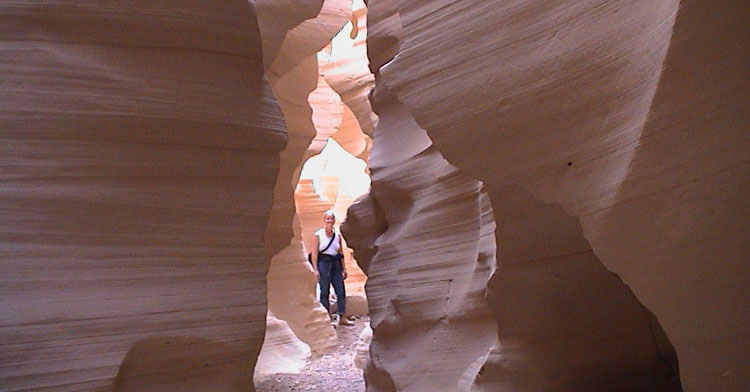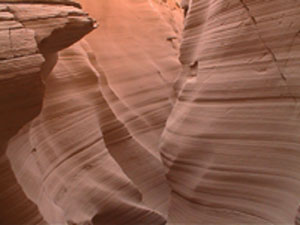
The writing’s on the wall
© Chad Clark 20-8-00
 Sandstone.
We’ve all come across it, but what is it exactly ? A brief lesson in geology tells us
all. Did you know that it’s the second most common sedimentary rock after shale ? Did
you also know that it consists of only two components ? The first component is a framework
of sand sized grains of quartz, feldspar and rock fragments. The second component is the
gaps between them. These gaps may be empty but in most cases are filled with silica or
calcium carbonate, the relative proportions of which allow scientists to determine both
the source area and the rate of deposition.
Sandstone.
We’ve all come across it, but what is it exactly ? A brief lesson in geology tells us
all. Did you know that it’s the second most common sedimentary rock after shale ? Did
you also know that it consists of only two components ? The first component is a framework
of sand sized grains of quartz, feldspar and rock fragments. The second component is the
gaps between them. These gaps may be empty but in most cases are filled with silica or
calcium carbonate, the relative proportions of which allow scientists to determine both
the source area and the rate of deposition.
Although it’s very soft, sandstone has an inherent ability to protect itself by absorbing the minerals from falling rain water to form a hard protective ‘patina’ or outer covering. This also effectively makes any surface markings harder and deeper. Combined with the tanning effect of the sun, the depth and colour of markings can be studied to determine their age. Some edges are smooth, caused by erosion from water travelling down through the sandstone to sea level, other edges are hard denoting a recent break due to earthquakes or other ‘natural’ forces such as man.
That’s the science of sandstone. A little boring I know, but the history of sandstone is much more interesting :
When the oceans covering North West Africa slowly retreated, they left behind sediments lying on the newly exposed land. These sandy sediments dried and became hardened, forming sandstone. As various peoples and caravans passed through Sinai they used this soft stone as a way of communicating with each other in the form of inscriptions. From the ancient Hebrews passing through the desert landscape, Nabatians reaching out from Jordan, Christian Pilgrims and Crusaders on their way to St.Catherines monastory to Muslims on their way to Mecca. They all left behind them inscriptions in the soft face of the stone, detailing not only the stories and legends of their nations and religions, but also ‘signposts’ to the next water holes, a kind of ancient route map to the next service station, a welcomed assisitance in staying alive whilst travelling through this arid landscape.

These writings and drawings depict the varied history of the land we call Sinai, with its battlegrounds along the north coast, holy wars and occasionally peace. Most of the inscriptions are to be found in the shaded places. This is where the caravans sought some cool respite from the heat of the day, resting in the shade of the sandstone canyons and passing their time persuing an ancient form of graffiti, etching letters and drawings into the sandstone, literally writing on the wall.
Over in Egypts Eastern Desert, a curious arrangement of sandstone megaliths at Nabta may well be the oldest astronomically inspired site on record. Its ‘calendar circle’ is broken by two sets of sighting windows. One is along the north-south axis and the other lines up exactly with sunrise on the morning of the summer solstice. Being only one degree south of the Tropic of Cancer, the midday sun reaches it’s zenith around this time causing all shadows to dissappear. Excavations under the largest megalith revealed a two ton rock shaped into a cow. Radiocarbon dating of the wood and charcoal found at the site suggest a period around 5000 BC, two thousand years before any similar astronomical sites found in Europe. It is believed that the architects of Nabta shared a complex belief based on sun, rain, death and cattle that may well have influenced the culture of Egypts Old Kingdom which arose centuries later in the Upper Nile Valley.
The highest dune in Africa, standing at around 300 metres above sea level, is to be found just north of Dahab on the Nuweiba road. For over 30 km along the asphalt road to St Catherines you’ll see sandstone stretching out either side, looking like massive rivers of melting wax. Closer examination will reveal a multitude of inscriptions depicting ancient events and directions. For me, graffiti will never seem the same again.
back